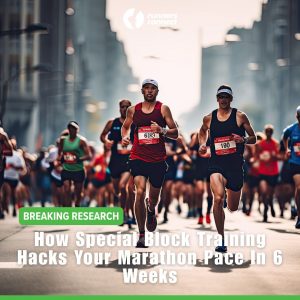Learning to properly pace yourself during a race is one of the most critical skills a runner can develop. To maximize your potential on race day, you need to become a master at pacing yourself and learning to feel the disparity between just a few seconds difference in your pace. By learning the importance of pacing and fine-tuning your skills, you can improve your consistency and set new personal bests.
How pacing affects race performance
Setting a new personal best can be decided by the smallest of margins, especially if you are an experienced runner who is maximizing your training. A reduction in performance by even a few percentage points can prevent you from reaching your potential. Let’s take a look at how critical pacing can be at some commonly run distances.
Pacing for shorter events like the 5k
Studies have shown that running the first mile of a 5k 3% faster than goal pace is the optimal pacing strategy. However, running the first mile more than 6% faster than goal race pace considerably reduces performance; so much so that almost all the subjects that ran faster than 6% failed to even finish the race.
Let’s use a 20 minute 5k runner to illustrate this concept. The average pace per mile for a 20 minute 5k is 6:26 per mile. To remain within the optimal 3% pace range, your first mile could be as fast as 6:15.
With the adrenaline pumping from the competition around you and other runners throwing you off pace, remaining within an 11 seconds per mile pace range is quite difficult. The margin between success and failure is razor thin and the consequences of starting out too fast are dire if your goal is to set a new PR.
Pacing for the Marathon
The proper race strategy for a marathon actually follows the exact opposite theory of a 5k. For a successful marathon race, you should target a pace that is about 3% slower (10 to 15 seconds per mile) than your goal marathon pace for the first 3 or 4 miles.
If you’ve trained for a marathon, you’ve probably encountered the term ” putting time in the bank”, which refers to running the first half of the marathon slightly faster than goal pace to compensate for being slow the last 10km of the race. Unfortunately, this racing strategy couldn’t be more wrong, both from a physiological standpoint and from empirical evidence.
The main problem with the “time in the bank” strategy concerns the use of carbohydrates or fats as a primary fuel source. One of the limiting factors in marathon performance is how efficiently you can burn fat instead of carbohydrates for energy. Once you burn through your available carbohydrate stores, your performance will suffer, most notably from “bonking” or running out of fuel. Unfortunately, the faster you run, the more carbohydrates you burn (study here). Therefore, by starting faster than goal pace and putting “time in the bank” you’re actually burning through your available carbohydrate stores faster and you will almost certainly run out of fuel and bonk.
To prevent bonking, you must adhere strictly to your goal marathon pace. Why? Your goal marathon pace corresponds to your aerobic threshold. Your aerobic threshold is the point at which you start relying on anaerobic respiration . Anaerobic respiration requires higher amounts of glycogen than aerobic running (study here), so you burn carbohydrates more quickly when you rely on anaerobic respiration.
Therefore, making the mistake of running 10-15 seconds faster than your goal marathon pace, even for just a few miles, can cause you to bonk or be detrimental to finishing as fast as you possible can.
Empirical evidence to support the importance of pacing
Studies are great, but as any researcher knows, they can be flawed for a variety of reasons. I think a more telling sign concerning the importance of pacing can be seen when we analyze the greatest performances in running history – world records. Here’s a stat for you: every world record from the 1500 meters to the marathon, both men’s and women’s, has been set running negative splits – running the first portion of the race slightly slower than the second half (study link).
The evidence is concrete. To race your best, you need to practice your pacing.
How to Practice Pacing
Like the “10,000 hour” rule Malcolm Gladwell discusses in Outliers, to improve your ability to pace yourself, you simply must practice – it’s as simple as that. Learning to pace yourself when running isn’t something that comes easy. It takes countless miles on the road and laps around the track to develop an inherent sense of pace. Here are some tips that might help you:
Stop relying on the Garmin
The Garmin is a great tool, but runners can often become too dependent on checking the watch every 10-15 seconds to monitor their pace. Next time you do a workout with the Garmin, check the watch the first 2-3 minutes to make sure you’re on pace and then don’t look at the watch again until you’re finished that mile or the entire run. Feel the pace you’re running after the first 2-3 minutes. Listen to your breathing; feel the rhythm in your legs, the motion of your arms. You won’t do a great job the first time you try, but after the third or fourth time, you’ll notice a substantial improvement.
Use your breathing
Monitor your breathing rhythm to help you feel the pace. Once you lock onto your correct goal pace for the workout, you can monitor whether you begin to breathe faster or you change your breathing rhythm to identify when you accidentally speed up or slow down.
Workouts
Implement workouts into your training routine that require you to change paces frequently. Cutdown runs and alternating tempos are a great way to teach yourself what the slight differences in paces feel like. In addition, these types of workouts can demonstrate to you how the effort required to maintain pace gets harder as the race goes on.
Be Patient
Learning how to control your pacing is difficult, but it is an essential skill to racing faster and improving your fitness. Don’t expect to see changes after one or two workouts. Rather, work on one of these tricks in each workout until you start to get a natural sense of pace. Before you know it, you’ll be running on target pace without even looking at your Garmin.
Don’t hesitate to ask questions or tell us about your experience with pacing in the comments section. Is there a pacing trick that you’ve tried that works well?






8 Responses
Thanks for this post! Very useful! I actually don’t own a Garmin but want to get one for Christmas. I’m pretty good at staying at the same pace but not sure if my natural pace is too fast or not for my marathon pace.
Glad I could help Samantha. Yes, the Garmins do help a lot at the beginning, but a natural sense of pace is better in the long-term
Thanks Coach! I was wondering if I should apply the same to half marathon as with marathon for the first 6 miles (3% less). My half pace is 9:20.
Hi Janine, I would run the first 2-3 miles of a HM 3% slower than goal pace, then goal pace for miles 3-11 or 12, and then finish as hard as you can the last 1-2 miles. This will allow you to conserve energy and finish fast. Good luck!
HI Coach Jeff,
I don’t feel a difference at 3%, up or down. If fact I am a mess at figuring out what my threshold is.
Would you apply the same % for a 10 mile race?
Thanks
Pacing is definitely a tough skill to learn, but if you keep chipping away at it, you’ll get better and better. I would apply the same pacing strategy to a ten mile race as a HM. Physiologically, they are almost exactly the same. Best of luck!